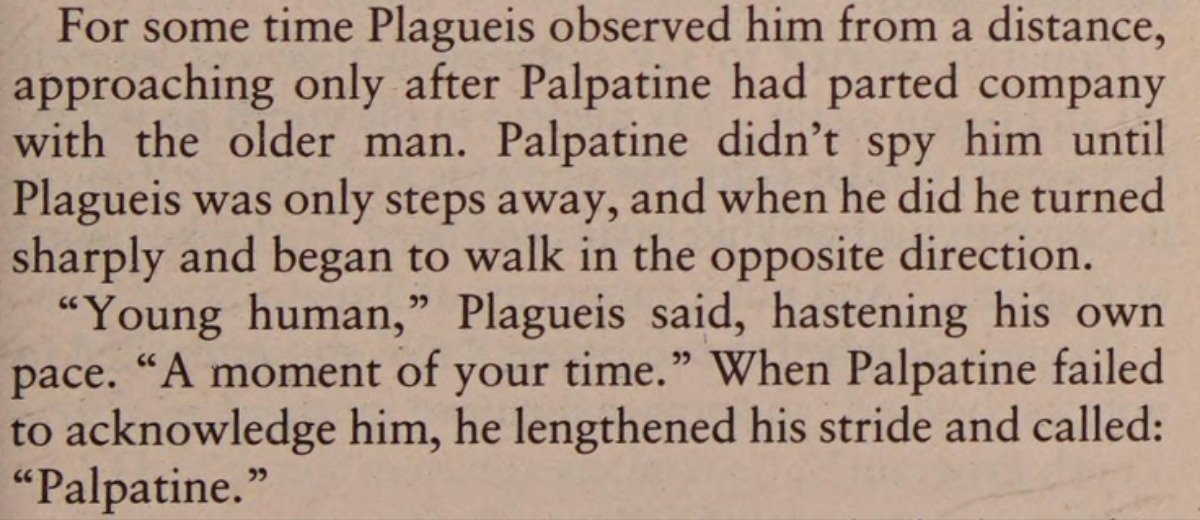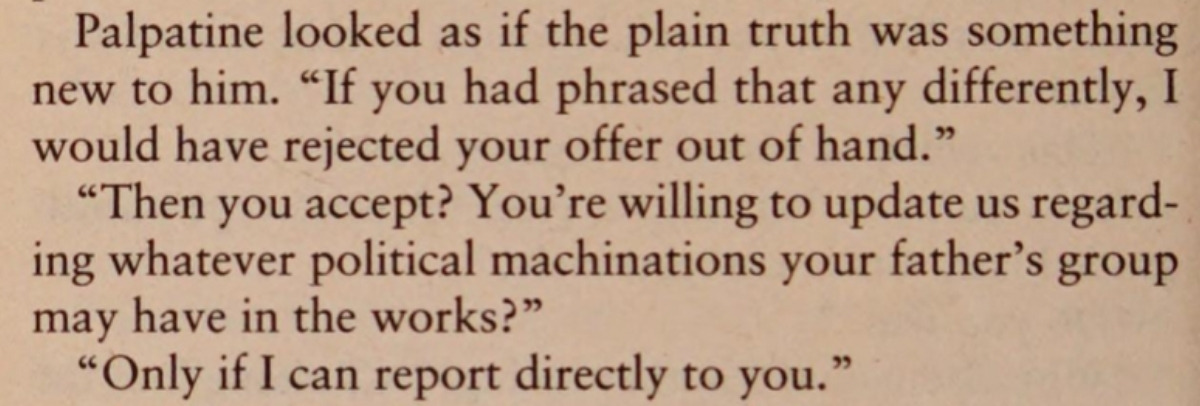Have you ever stop and think about how wild it is that the Jedi missed Palpatine as a kid? Like, this guy grows up to be Darth Sidious, wipes out the whole Order, becomes Emperor… and yet nobody from the Temple ever showed up at his door. Naboo isn’t some totally forgotten rock either, it’s a pretty polished Mid Rim world. Still, no Jedi recruitment, no “we sense something about this boy,” nothing.
So what gives? Was it bad timing, sloppy Jedi scouting, or was there something about Palpatine that made him harder to spot? Let’s find out!
The Sith Got There First
In Darth Plagueis, Palpatine is not uncovered through a Force vision or Jedi-like search but through a political maneuver accidentally. Plagueis first encounters the youth while observing Naboo’s elite, spotting him among the Legislative Youth Program. The approach is entirely mundane:
“Palpatine didn’t spy him until Plagueis was only steps away, and when he did he turned sharply and began to walk in the opposite direction.” (p.141)

Their early exchanges reveal that Plagueis came to Naboo to back a political candidate, not to scout Force prodigies. Palpatine recognizes him only as Hego Damask, the Magister of Damask Holdings:
“You’re Hego Damask. The president—no, the ‘Magister’—of Damask Holdings. My father said that you were coming to Naboo to meet with Bon Tapalo. Your group is shoring up his bid for the throne.” (p.142)

This establishes the crucial fact: Plagueis meets Sheev by coincidence of politics, not because his Force presence stood out. Their bond begins in political intrigue—Palpatine even insists on reporting directly to Plagueis when he offers him a role:
“Only if I can report directly to you.” (p.146)

What grows into Sith apprenticeship begins not with destiny or a Force search but with ambition, secrecy, and personal manipulation. By the time the Jedi might have had reason to notice him, Plagueis had already “claimed” him—accidentally, but decisively.
A Presence That Hid In Plain Sight
The novel also underscores how unusual Palpatine’s Force presence was—so much so that it eluded detection even by Plagueis, who submerged himself in the Force during their early meetings:
“Plagueis submerged himself deeply in the Force to study Palpatine, but he was unable to glean very much. Humans were difficult to read in the easiest of cases, and Palpatine’s mind was awash in conflict.” (p.144)

This strangeness went beyond normal difficulty. Later, Plagueis realizes the truth: Palpatine carried such immense raw power that the Force itself seemed to seal it away, cloaking him from perception until the right time. The narrative makes it explicit:
“Again he tried to see deeper into Palpatine, but without success. The psychic walls the youth had raised were impenetrable, which made the young human something rare indeed. Had Palpatine somehow learned to corral the Force within himself, as Plagueis had concealed his own powers as a youth?” (p.151)

That paradox—that overwhelming strength could equal invisibility—made him nearly impossible to detect during youth. Even Plagueis, who later thought, “Before long, I will own this human” (p.149), did not initially perceive the depth of what he had found.
For the Jedi, who were not even present on Naboo, the odds of stumbling onto such a cloaked presence were essentially zero. Palpatine’s muted signature, combined with Plagueis’s own initial blindness, shows why no one “felt” him before he stepped fully into Sith tutelage. His presence was hidden in plain sight by the very Force he would one day bend to his will.
The Odds Weren’t On The Jedi’s Side
Next, the Order fielded around 10,000 Jedi across a galaxy with millions of worlds and countless communities. That setup means seekers could visit many places but never all of them. Travel takes time, local records vary, and leads dry up. Coverage was never complete, even in calm years, and the system leaned on chance meetings, trusted messengers, and slow circuits through the Mid and Outer Rim. As one fan likes to put it: “With only 10,000 Jedi in a galaxy that size, you miss people.”
The takeaway here guides the rest: limited reach opens gaps, and talented kids can slip through those gaps without any dramatic cover-up.
Holes In The Jedi Process
Even in the Core, the Order relied on a practical mix of methods: travel, Temple correspondents, medical readings where available, and tips from local leaders. That approach works best where people welcome it. Not every culture does, and not every official waves down a passing Knight about a strange, gifted student. The Order relied on travel, tips, and local help, and that creates uneven results across sectors.
When the Clone Wars later start pulling Jedi to active fronts, these gaps widen. But for Palpatine’s childhood era, the key factor is still basic logistics: few seekers, huge territory, and a planet that didn’t sit on their route.
Naboo Stayed Off The Map For Too Long
Now add location. Palpatine grew up on Naboo, a refined but quiet Mid Rim world that didn’t pull steady Jedi traffic before the Trade Federation mess in 32 BBY. The planet sat far from hot zones and major Jedi deployments. An isolated homeworld lowers the chances of a seeker knocking on your door, and Naboo’s politics stayed local until the blockade pushed it into the spotlight.
So if you combine thin coverage with a low-traffic sector, you get long stretches where no Jedi visit at all—and no one notices the gifted kid in the governor’s neighborhood.
A Noble Family That Kept Things Quiet
Sheev was the eldest son in a Naboo noble house. That kind of household brings privacy, leverage, and a way to smooth over school issues or outbursts. A noble house can hide a lot of noise, and servants or teachers who value their positions don’t rush reports to off-world authorities. One line you often hear from fans goes, “If your father is a power broker, fewer people ask questions.”
This social layer explains why rumors about an unusual child didn’t travel far. Instead of drifting to a Jedi outpost, they settle inside a manor and vanish into the family routine.

